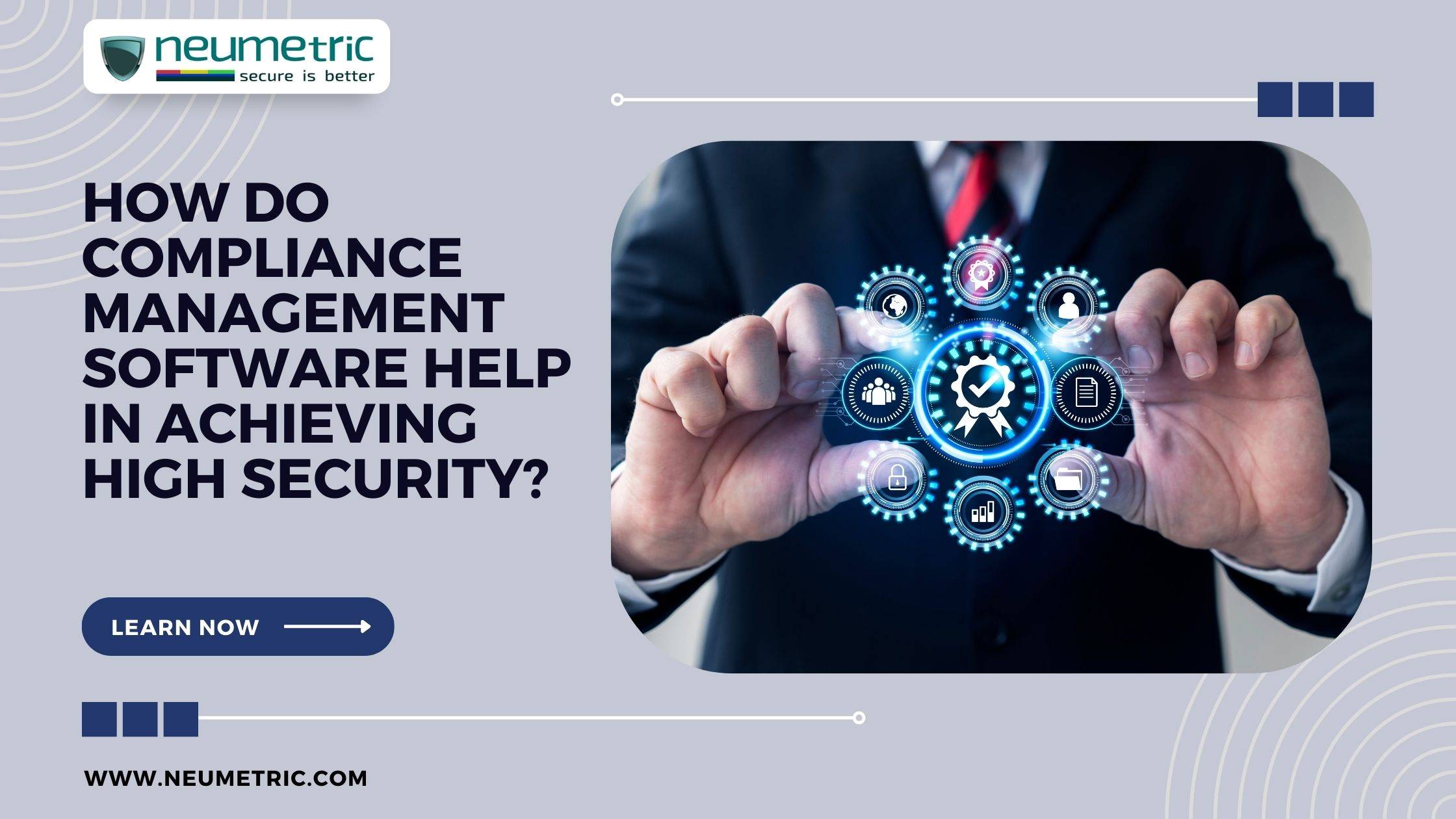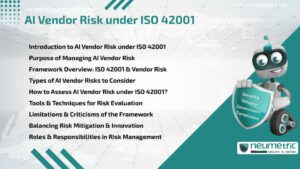Table of Contents
ToggleIntroduction
In recent years, we’ve witnessed an unprecedented surge in the digitalization of businesses and services. From small startups to global conglomerates, everyone’s riding the wave of the digital revolution. This evolution, while fostering efficiency and innovation, has also brought with it a plethora of risks and challenges.
The vast interconnectedness of today’s world means that a single vulnerability can ripple out, affecting countless systems and data points. Consequently, the importance of security and compliance cannot be overstated. These are not mere checkboxes to tick off but critical imperatives for any organisation that wishes to maintain its credibility, protect its assets & ensure longevity in the digital era.
Understanding Compliance Management Software (CMS)
At its core, Compliance Management Software (CMS) is a tool designed to help organizations navigate the complex waters of regulatory and industry standards. Think of it as a sophisticated digital assistant that monitors, evaluates & ensures that a company’s operations remain within the boundaries of established norms and regulations.
The rise of CMS stems from a fundamental need: as regulations multiply and evolve, manually ensuring compliance becomes a Herculean task. CMS automates and streamlines this process, allowing businesses to focus on growth without being weighed down by compliance concerns.
Core Features and Functionalities of CMS:
Automated Monitoring and Alerts: Continuously scans processes to identify potential breaches, sending out alerts before issues escalate.
Centralized Repository: Provides a single point of storage for all compliancerelated documents, making retrieval and updates efficient.
Audit Trails: Logs every action taken, offering clear transparency and accountability.
Assessment and Reporting Tools: Offers insights into compliance status & generates detailed reports for internal reviews and external audits.
Integration Capabilities: Seamlessly integrates with other enterprise tools, ensuring that compliance permeates every aspect of an organization’s operations.
The Symbiosis of Compliance and Security
At a glance, compliance and security might seem like distinct domains – one dealing with adhering to rules, the other with protecting assets. However, in the digital realm, they’re deeply intertwined.
Exploring How Compliance is an Integral Part of Security:
Compliance standards are often established in response to known vulnerabilities and threats. For instance, regulations might dictate that sensitive customer data should be encrypted or that financial transactions should follow specific protocols. By adhering to these standards, organizations inherently bolster their security posture. Compliance, in essence, provides a roadmap to a more secure operational framework.
The Inherent Risks of NonCompliance:
Apart from legal repercussions and hefty fines, noncompliance carries significant security risks:
Exposure to Known Threats: Ignoring compliance is equivalent to neglecting established best practices, leaving systems vulnerable.
Reputation Damage: Data breaches, especially those resulting from noncompliance, can tarnish a company’s image, leading to loss of customer trust and business opportunities.
Operational Disruptions: Noncompliant systems may face shutdowns or restrictions until issues are resolved.
In conclusion, while compliance might be driven by regulatory bodies and industry standards, its essence lies in fostering a culture of security and responsibility. In the vast digital ecosystem, Compliance Management Software acts as the compass, guiding organizations towards safer shores.
Key Ways CMS Enhances Security
a. Automated Monitoring:
In today’s fastpaced digital landscape, it’s impractical, if not impossible, for organizations to manually monitor all their processes and data. CMS fills this gap through Automated Monitoring.
Continuous monitoring of data and processes: CMS tools are equipped with the capability to constantly scan and evaluate data flow and operational processes. This ensures that deviations from compliance norms are detected in realtime, reducing the window of vulnerability.
Instant alerts for any compliance and security breaches: Immediate notification is the key to swift action. The moment a potential breach or noncompliance is detected, stakeholders receive instant alerts, enabling them to take corrective action before the issue magnifies.
b. Centralized Documentation:
Document management is crucial when it comes to compliance and security.
Safe storage of all compliancerelated documents: With CMS, organizations can store all their compliance documentation in a singular, secure digital location. This not only ensures easy accessibility but also guarantees that critical documents are shielded from unauthorized access, loss, or damage.
Controlled access to sensitive information: CMS allows rolebased access controls, ensuring that sensitive compliance information is accessible only to those with the appropriate permissions. This is critical in preventing both external breaches and internal misuse.
c. Regular Audits and Assessments:
Audits are the litmus test for an organization’s compliance health.
Automated scheduling and tracking of internal and external audits: Gone are the days of manual audit scheduling. CMS tools can automatically schedule, track & even send reminders about upcoming audits, ensuring that organizations are always prepared.
Assessment tools that pinpoint vulnerabilities: Advanced CMS solutions come equipped with tools that not only assess the current compliance status but also identify potential vulnerabilities. This proactive approach ensures that weak points are strengthened before they can be exploited.
d. Training and Knowledge Base:
An informed team is the first line of defense against noncompliance and security threats.
Offering continuous training modules for employees: Compliance norms and security standards evolve. With CMS, organizations can provide continuous training modules, ensuring that their teams are always updated and aligned with the latest requirements.
Updated knowledge bases to stay informed about the latest compliance and security standards: CMS tools often come with integrated knowledge bases, offering resources, best practices & updates about changes in compliance standards and security threats.
e. Incident Management:
In the unfortunate event of a security incident, rapid and efficient response is vital.
Effective tracking of security incidents: CMS solutions allow organizations to log, track & evaluate security incidents, providing insights into patterns, repeated vulnerabilities & areas that need attention.
Swift response mechanisms to mitigate threats: Integrated workflows within CMS ensure that the moment an incident is detected, a predefined response mechanism is activated. Whether it’s alerting the IT team, initiating data backups, or communicating with stakeholders, CMS ensures that the response is timely and effective.
In sum, Compliance Management Software is more than just a tool; it’s a holistic approach to intertwining compliance and security, ensuring that organizations are both shielded from threats and aligned with regulatory norms.
Case Studies of Businesses That Fortified Their Security Using CMS:
Financial Institution Reinforces Data Protection:
A renowned bank, with branches globally, once faced a significant data breach, exposing sensitive customer information. Post this incident, the bank invested in a robust CMS. This system continually monitored all transactions, instantly detected suspicious activities & flagged any unauthorized data access. Within months of implementation, the bank reported a 95% reduction in security incidents and regained customer trust.
Healthcare Provider Enhances Patient Data Security:
A leading healthcare provider, managing patient data from multiple clinics, grappled with ensuring data confidentiality and meeting stringent medical data protection standards. Implementing a CMS helped them centralize patient records, control data access based on roles & instantly alert the IT team about potential data breaches. The result was an enhanced patient trust and adherence to compliance requirements.
Lessons Learned From These Implementations:
1. Proactivity Over Reactivity: Waiting for a breach to occur can be catastrophic. Investing in CMS before a significant incident ensures prevention and builds customer trust.
2. Customization is Key: Each industry and business has unique compliance and security needs. A onesizefitsall approach doesn’t work. The chosen CMS must cater to specific business requirements.
Choosing the Right CMS for Enhanced Security
Factors to Consider:
Scalability: As businesses grow, their data, processes & compliance requirements will expand. It’s imperative that the chosen CMS can scale up without causing disruptions.
Userfriendliness: A CMS should have an intuitive interface. If the software is too complicated, employees might bypass or misuse it, defeating its purpose.
Industryspecific Needs: A financial institution’s compliance needs differ from those of a retail store. Ensure the CMS caters to industryspecific regulations and challenges.
Integration: The CMS should seamlessly integrate with other tools and systems in the organization, ensuring endtoend compliance and security.
Common Pitfalls to Avoid:
Overreliance on Automation: While automation is helpful, human oversight is crucial. Ensure there’s a balance between automation and human monitoring.
Ignoring Regular Updates: Compliance norms and security threats evolve. Regularly updating the CMS is nonnegotiable.
Future of Compliance and Security: Role of CMS
Predictions About the Evolving Nature of Threats:
Sophisticated Attacks: With advancements in technology, cyberattacks will become more sophisticated, requiring businesses to stay a step ahead.
IoT and Big Data: As more devices get connected and businesses rely heavily on data analytics, securing vast amounts of data and ensuring compliance will be more challenging.
How CMS will Adapt and Evolve to Meet These Challenges:
AI and Machine Learning Integration: Future CMS tools will likely harness AI to predict threats, understand evolving compliance norms & offer solutions even before problems arise.
Blockchain for Data Integrity: Ensuring data hasn’t been tampered with is crucial. CMS tools might integrate blockchain technology to ensure data integrity.
Continuous Learning Modules: As threats evolve, continuous learning will be paramount. CMS tools will provide regular training modules, ensuring employees are always aware of the latest threats and compliance norms.
In the digital age, threats and compliance requirements will continue to evolve. However, with robust Compliance Management Software in place, businesses can navigate these challenges effectively, ensuring both security and regulatory adherence.
Conclusion
In our rapidly evolving digital landscape, the boundaries between security and compliance are becoming increasingly blurred. As we’ve delved into the intricacies of Compliance Management Software (CMS) and its integral role in fortifying an organization’s security posture, one thing remains abundantly clear: CMS isn’t just an operational tool; it’s a strategic asset.
Reinforcing the Importance of Leveraging CMS for Heightened Security:
Businesses, now more than ever, operate in an environment teeming with both visible and hidden threats. From cyberattacks to data breaches, the risks are manifold. But beyond these threats, businesses also grapple with a myriad of compliance regulations. Neglecting either front can lead to disastrous consequences, both reputationally and financially. Here, CMS emerges as the bridge between these two critical pillars, offering a comprehensive solution that bolsters security while ensuring compliance.
Encouraging Businesses to Prioritize Both Compliance and Security in Their Operations:
The debate isn’t about choosing between compliance and security; it’s about understanding their interdependence. By adopting and effectively leveraging CMS, businesses are sending out a clear message: they value the trust of their stakeholders and are committed to safeguarding their interests. In this age of information, that commitment can set a business apart, fostering trust, loyalty & sustained growth.
FAQs
Q: What are the costs associated with implementing CMS?
A: The costs of CMS can vary widely based on several factors: the size of the organization, the industryspecific requirements, the features needed & the chosen vendor. While there are upfront costs in purchasing and implementing CMS, it’s crucial to view this as an investment. The potential financial implications of a security breach or noncompliance incident can far outweigh the initial costs of a CMS solution.
Q: Can small businesses benefit from CMS?
A: Absolutely! While large corporations might be the more frequent targets of highprofile attacks, small businesses are not immune. In fact, many cybercriminals target small businesses, assuming they might have laxer security protocols. Implementing a CMS can provide a protective shield, ensuring data integrity & adherence to relevant compliance norms. Moreover, many CMS vendors offer scalable solutions tailored for small businesses, making them both affordable and effective.
Q: How often should businesses update their CMS solutions?
A: Regular updates are vital to ensure the CMS remains effective against evolving threats and changing compliance norms. Most reputable CMS vendors provide periodic updates to address these changes. It’s recommended that businesses apply these updates as soon as they’re available. Additionally, a more comprehensive review of the CMS solution can be undertaken annually to assess if a more significant upgrade or even a shift to a different solution is warranted.
In the final reckoning, in our interconnected world, security and compliance are two sides of the same coin. By understanding and addressing both, businesses can navigate the digital age with confidence and integrity.





